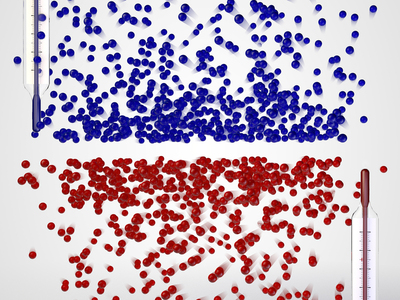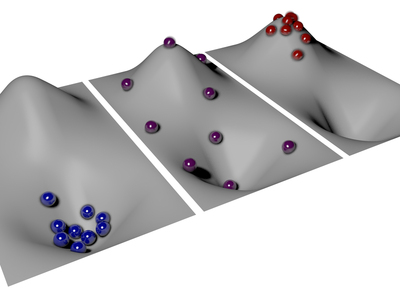A temperature below absolute zero
Atoms at negative absolute temperature are the hottest systems in the world.
On the absolute temperature scale, the Kelvin scale, it is not possible to go below zero - at least not in the sense of getting colder than zero Kelvin. According to the physical meaning of temperature, the temperature of a gas is determined by the chaotic movement of its particles - the colder the gas, the slower the particles. At 0 K (-273°C) the particles stop moving and all disorder disappears. Thus, nothing can be colder than absolute zero on the Kelvin scale. Physicists at the Ludwig-Maximilians University Munich and the Max Planck Institute of Quantum Optics in Garching have now created an atomic gas in the laboratory that nonetheless has negative Kelvin values. These negative absolute temperatures have several apparently absurd consequences: although the atoms in the gas attract each other and give rise to a negative pressure, the gas does not collapse - a behaviour that is also postulated for dark energy in cosmology. Supposedly impossible heat engines such as a combustion engine with a thermodynamic efficiency of over 100% can also be realised with the help of negative absolute temperatures.

In order to bring water to the boil, energy needs to be added. As the water heats up, the water molecules increase their kinetic energy over time and move faster and faster on average. Yet, the individual molecules possess different kinetic energies - from very slow to very fast. Low-energy states are more likely than high-energy states, ie, only a few particles move really fast. In physics, this distribution is called the Boltzmann distribution. Physicists working with Ulrich Schneider and Immanuel Bloch have now realised a gas in which this distribution is precisely inverted: many particles possess high energies and only a few have low energies. This inversion of the energy distribution means that the particles have assumed a negative absolute temperature.
“The inverted Boltzmann distribution is the hallmark of negative absolute temperature; and this is what we have achieved,” says Ulrich Schneider. “Yet the gas is not colder than zero Kelvin, but hotter,” as the physicist explains: “It is even hotter than at any positive temperature - the temperature scale simply does not end at infinity, but jumps to negative values instead.”
A negative temperature can only be achieved with an upper limit for the energy
The meaning of a negative absolute temperature can best be illustrated with rolling spheres in a hilly landscape, where the valleys stand for a low potential energy and the hills for a high one. The faster the spheres move, the higher their kinetic energy as well: if one starts at positive temperatures and increases the total energy of the spheres by heating them up, the spheres will increasingly spread into regions of high energy. If it were possible to heat the spheres to infinite temperature, there would be an equal probability of finding them at any point in the landscape, irrespective of the potential energy. If one could now add even more energy and thereby heat the spheres even further, they would preferably gather at high-energy states and would be even hotter than at infinite temperature. The Boltzmann distribution would be inverted, and the temperature therefore negative. At first sight it may sound strange that a negative absolute temperature is hotter than a positive one. This is simply a consequence of the historic definition of absolute temperature, however; if it were defined differently, this apparent contradiction would not exist.
This inversion of the population of energy states is not possible in water or any other natural system as the system would need to absorb an infinite amount of energy - an impossible feat! However, if the particles possess an upper limit for their energy, such as the top of the hill in the potential energy landscape, the situation will be completely different. The researchers in Immanuel Bloch’s and Ulrich Schneider’s research group have now realised such a system of an atomic gas with an upper energy limit in their laboratory, following theoretical proposals by Allard Mosk and Achim Rosch.
In their experiment, the scientists first cool around a hundred thousand atoms in a vacuum chamber to a positive temperature of a few billionths of a Kelvin and capture them in optical traps made of laser beams. The surrounding ultrahigh vacuum guarantees that the atoms are perfectly thermally insulated from the environment. The laser beams create a so-called optical lattice, in which the atoms are arranged regularly at lattice sites. In this lattice, the atoms can still move from site to site via the tunnel effect, yet their kinetic energy has an upper limit and therefore possesses the required upper energy limit. Temperature, however, relates not only to kinetic energy, but to the total energy of the particles, which in this case includes interaction and potential energy. The system of the Munich and Garching researchers also sets a limit to both of these. The physicists then take the atoms to this upper boundary of the total energy - thus realising a negative temperature, at minus a few billionths of a Kelvin.
At negative temperatures an engine can do more work
If spheres possess a positive temperature and lie in a valley at minimum potential energy, this state is obviously stable - this is nature as we know it. If the spheres are located on top of a hill at maximum potential energy, they will usually roll down and thereby convert their potential energy into kinetic energy. “If the spheres are at a negative temperature, however, their kinetic energy will already be so large that it cannot increase further,” explains Simon Braun, a doctoral student in the research group. “The spheres thus cannot roll down, and they stay on top of the hill. The energy limit therefore renders the system stable!” The negative temperature state in their experiment is indeed just as stable as a positive temperature state. “We have thus created the first negative absolute temperature state for moving particles,” adds Braun.

Matter at negative absolute temperature has a whole range of astounding consequences: with its help, one could create heat engines such as combustion engines with an efficiency of more than 100%. This does not mean, however, that the law of energy conservation is violated. Instead, the engine could not only absorb energy from the hotter medium, and thus do work, but, in contrast to the usual case, from the colder medium as well.
At purely positive temperatures, the colder medium inevitably heats up in contrast, therefore absorbing a portion of the energy of the hot medium, and thereby limits the efficiency. If the hot medium has a negative temperature, it is possible to absorb energy from both media simultaneously. The work performed by the engine is therefore greater than the energy taken from the hotter medium alone - the efficiency is over 100%.
The achievement of the Munich physicists could additionally be interesting for cosmology, since the thermodynamic behaviour of negative temperature exhibits parallels to so-called dark energy. Cosmologists postulate dark energy as the elusive force that accelerates the expansion of the universe, although the cosmos should in fact contract because of the gravitational attraction between all masses. There is a similar phenomenon in the atomic cloud in the Munich laboratory: the experiment relies on the fact that the atoms in the gas do not repel each other as in a usual gas, but instead interact attractively. This means that the atoms exert a negative instead of a positive pressure. As a consequence, the atom cloud wants to contract and should really collapse - just as would be expected for the universe under the effect of gravity. But because of its negative temperature this does not happen. The gas is saved from collapse just like the universe.
Light pollution promotes blue-green algae growth in lakes
Artificial light at night promotes the proliferation of cyanobacteria, also known as blue-green...
Solar-powered reactor uses CO2 to make sustainable fuel
Researchers have developed a reactor that pulls carbon dioxide directly from the air and converts...
Scientists simulate the effects of an asteroid collision
How would our planet physically react to a future asteroid strike? Researchers simulated an...




